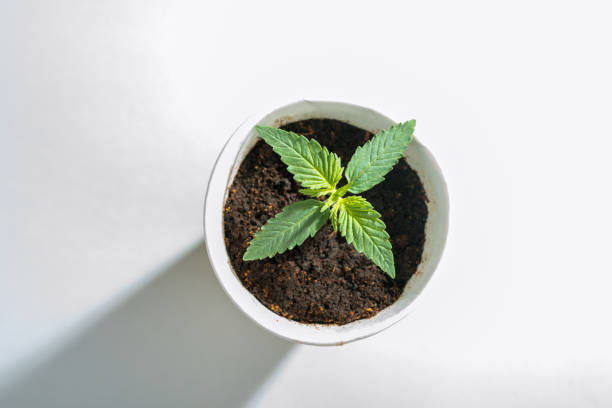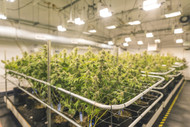Step-by-Step Guide on Growing Weed Indoors l HS CONTAINERS LLC
Jan 5th 2023
How to Grow Weed: A Step-by-Step Beginners Guide
Have you decided to take your green thumb to the next level and become a cannabis cultivator? Growing weed indoors is ideal for beginners since it allows them to control the environment and produce an excellent crop yield.
This guide explains all the steps needed to learn how to grow tasty buds from seed to harvest. So if you're ready, let's get started!
What Are the Benefits of Growing Weed Indoors?
Growing weed indoors has many benefits, including:
- Cannabis plants grown indoors are not subject to the same pests and diseases that can plague outdoor crops.
- It provides greater control over the humidity and temperature the plants get exposed to and the amount of light and nutrients they receive, allowing indoor growers to produce large, healthy harvests.
- Additionally, indoor growers enjoy more privacy and security than those who grow outdoors.
- Indoor growers have a wide variety of equipment and resources available, allowing them to tailor growing operations to specific needs.
How To Set Up an Indoor Cannabis Growing Room
For those looking to set up an indoor cannabis grow room, there are a few things to keep in mind.
- First, you'll need to find a suitable space - a spare room, garage, basement, or sealable cupboard.
- The grow room will also need to be kept light and dark - cannabis plants require around 12 hours of darkness each day, so during the plant's dark time, ensure you block all lights. Additionally, too much light can cause light stress in cannabis plants, leading to hermaphroditism (self-pollination).
- New growers should start with a small and manageable setup - for example, 3 feet by 3 feet. This setup can hold four to nine plants and only requires one light to cover the area.
Once you have your grow room set up, it's essential to understand the plant's growth patterns before moving on to more significant projects.
* Important Note: In some states, cannabis grown for personal use must remain out of public sight - so keep this in mind when choosing where to set up your grow room.
What Items Do You Need for Growing Weed Indoor
While setting up a grow room requires more equipment than outdoor growing, it also gives you more control over your plants and their surroundings. For example, the weather is unpredictable outdoors, but indoors you can adjust, which means healthier plants and more considerable yield potential.
A grow room is an enclosed space where you can control your plants' environment. It means adjusting the temperature, airflow, humidity, and lighting to create the perfect conditions for your plants.
So what do you need to set up a grow room? Here's a list of items you may need:
Lighting Requirements
In addition to buying lights, you will also need:
We recommend using light at 100-125 watts during the vegetative stage. It will help trigger flowering after 4-6 weeks of vegetation. A metal halide light's blue light emission during this phase is ideal.
Most growers use a grow light with 250 watts or more for the flowering stage, while sodium lights are preferred for flowering as they produce more red light.
Other options:
- Young seedlings and plant propagation benefit when grown under fluorescent lights.
- LED lights can be used for all stages of growth and are energy efficient but are more expensive upfront.
- Plasma and CDM lights may be worth considering for those that want to enhance flower production — though they are not required.
Proper Fan Placement
Proper fan placement is crucial to setting up an indoor cannabis grow room. Fans help circulate fresh air and create a positive environment for your plants to grow. Without proper ventilation, the air in the room would become stagnant, and plants would not get enough carbon dioxide to grow appropriately.
When setting up fans, it is essential to remember that warm air rises, so place extractor fans high up. Additionally, you will need intake fans that bring fresh air into the room on the opposite side of the extractor fan.
The size and number of fans you need will depend on your growing space, so be sure to plan accordingly. You may also need a dehumidifier or AC unit to regulate temperature and humidity levels.
Choosing an Indoor Grow Medium
For beginners, we recommend a soil-coco coir mix as it contains most of the nutrients needed for cannabis plant growth. You will still need to give your plants an occasional top-up with a nutrient mix and distilled water, but the maintenance is minimal overall.
Hydroponic trays or coco-coir-only growing mediums can be great choices if you're looking for something more advanced than soil growing. However, experience working with nutrients is ideal. But you can feed your plants rather than rely on pre-mixed nutrients.
How to Grow Cannabis Indoors
Growing weed indoors can be a fun and rewarding experience, but it does involve some critical steps. And understanding each growth stage's lighting and temperature needs and ensuring that your equipment runs appropriately is vital to success.
Step 1: Choose A Seed
Seeds should be dry, dark-colored, and stiff. You can find reputable seed sources online or at your local dispensary. When choosing between feminized and non-feminized seeds, keep in mind that feminized seeds save some time, but non-feminized seeds offer options for breeding.
If you're starting, we recommend feminized seeds. Short, squat varieties are best for growers in colder climates. These auto-flowering strains are also a good option for growers in colder climates because they mature at a certain age rather than a light cycle.
Hybridized strains are resistant to mold and pests and produce larger yields than pure Indica or Sativa strains that have been around for centuries.
Step 2: Germinate and Wait for Seedlings to Emerge
To germinate cannabis seeds, you'll need to place them on soaked paper plates or paper towels and keep them moist, and the taproot will emerge in a few days.
Once the taproots emerge, transfer the seeds to a growing medium and plant them 10 mm deep. Keep the growing medium damp but not overwatered.
Step 3: Transition Into the Vegetative Stage
Once your cannabis plant is sprouted and established, it's time to move into the vegetative stage.
Provide 18-24 hours of light each day and temperatures between 70 to 85 degrees Fahrenheit.
Additionally, water them regularly and deliver extra nutrients like nitrogen for optimal growth.
Wait for the signs of flowering before transitioning!
Bonus Advanced Step: Train Your Plants for Optimal Yields
Training is a method where growers manipulate the plant to produce more buds and grow a certain way. Multiple training techniques can help to maximize yield, such as the Sea of Green or Screen of Green methods. While this is an optional step, it can benefit experienced growers.
Step 4: Day Light Cycle/Flowering Stage
As the days pass, your female cannabis plants will thicken and develop heavy-scented buds. The energy focused on flower development will cause them to grow larger. You'll also notice more hairs and resin glands, as well as an increase in trichomes.
Once the buds have developed, you'll need to move them to a light cycle of 12 hours of darkness and 12 hours of light.
Stop training the plants towards the end of the flowering stage so they can focus on producing buds. You should also stop giving them nutrients and start to flush the plants with water.
Depending on the type, the flowering stage usually lasts six to 14 weeks, although most growers harvest when the trichomes are a mixture of cloudy and amber.
Step 5: Harvesting and Curing
The harvesting and curing process can take up to five weeks, but it is well worth the wait. During the curing process, it is crucial to trim the main stem and hang the plants dry.
Curing helps to improve and preserve the quality and taste of your cannabis in the long term.
Conclusion
Although it can be expensive to start, growing weed can save you a lot of money in the long run. Cannabis is a heavily taxed product, and dispensaries often charge high prices for rare varieties. By growing your cannabis, you can avoid these costs and enjoy your favorite strains at a fraction of the price.
Safety is also an important consideration when growing weed. Commercial cannabis may be grown with harsh chemicals, harmful to humans and the environment. When you raise your weed, you can control what goes into the soil and water, ensuring that your plants are healthy and safe to consume.
Finally, don't forget that a good weed grinder is essential for enjoying your homegrown weed. HerbTools offers a wide selection of weed grinders in all shapes and sizes.Browse our collection today and find the perfect weed grinder for your needs.


